AckermannTh. (ed) Wind Power in Power Systems
Подождите немного. Документ загружается.

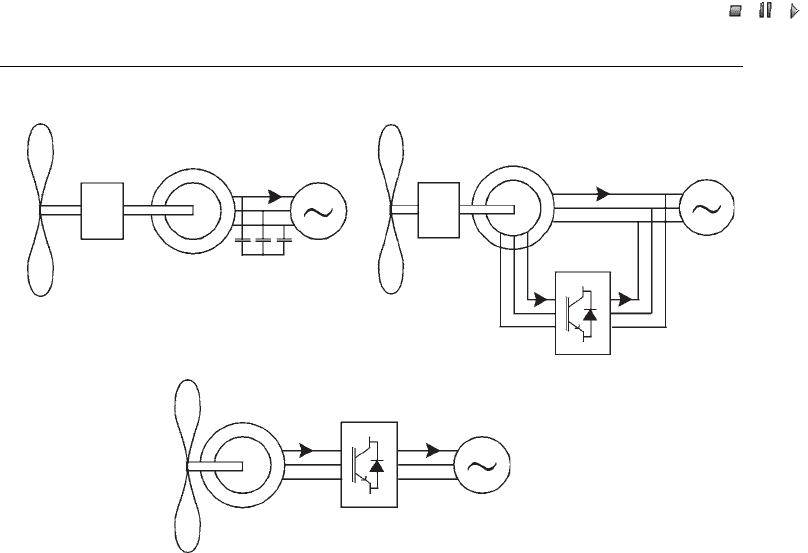
//INTEGRAS/KCG/P AGIN ATION/ WILEY /WPS /FINALS_1 4-12- 04/0470855088_ 20_CHA19 .3D – 421 – [411–432/22]
17.12.2004 10:55PM
The third type is called the ‘direct-drive wind turbine’ because it does not need a
gearbox. It corresponds to Type D in Section 4.2.3. A low-speed multipole synchronous
ring generator with the same rotational speed as the wind turbine rotor converts the
mechanical energy into electricity. The generator can have a wound rotor or a rotor with
permanent magnets. The stator is not coupled directly to the grid but to a power electronic
converter. This may consist of a back-to-back voltage source converter or a diode rectifier
with a single voltage source converter. The electronic converter makes it possible to
operate the wind turbine at variable speed. Similar to Type C, pitch control limits the
mechanical power input. Figure 19.2 presents the three main wind turbine types.
Apart from the wind turbine types depicted in Figure 19.2, other types have been
developed and used. They include wind turbines with directly grid coupled synchronous
generators and with conventional synchronous as well as squirrel cage induction gen-
erators combined with a gearbox and coupled to the grid with a full-scale power
electronic converter. Currently, there are hardly any of these wind turbine types on
the market, though, and we will not take them into consideration here.
19.3.2 Wind turbine voltage control capabilities
As mentioned above, node voltages are dependent on branch characteristics and on
branch currents. In transmission networks and distribution grids, node voltage and
Rotor
Direct-drive
synchronous
generator
Grid
Converter
U
c
U
s
I
c
I
s
Rotor
Rotor
Grid
Grid
Converter
U
s
U
r
U
s
I
s
I
s
I
cI
r
Doubly fed
(wound rotor)
induction
generator
Gearbox
Gearbox
Squirrel
cage
induction
generator
Compensating
capacitors
(a)
(b)
(c)
Figure 19.2 Widely used wind turbine types: (a) constant-speed wind turbine (Type A); (b)
variable-speed wind turbine with doubly fed induction generator (Type C); and (c) direct-drive
variable-speed wind turbine with multipole synchronous generator (Type D) Note: U ¼ voltage;
I ¼ current; subscripts s, r, c, stand for stator, rotor and converter, respectively
Wind Power in Power Systems 421
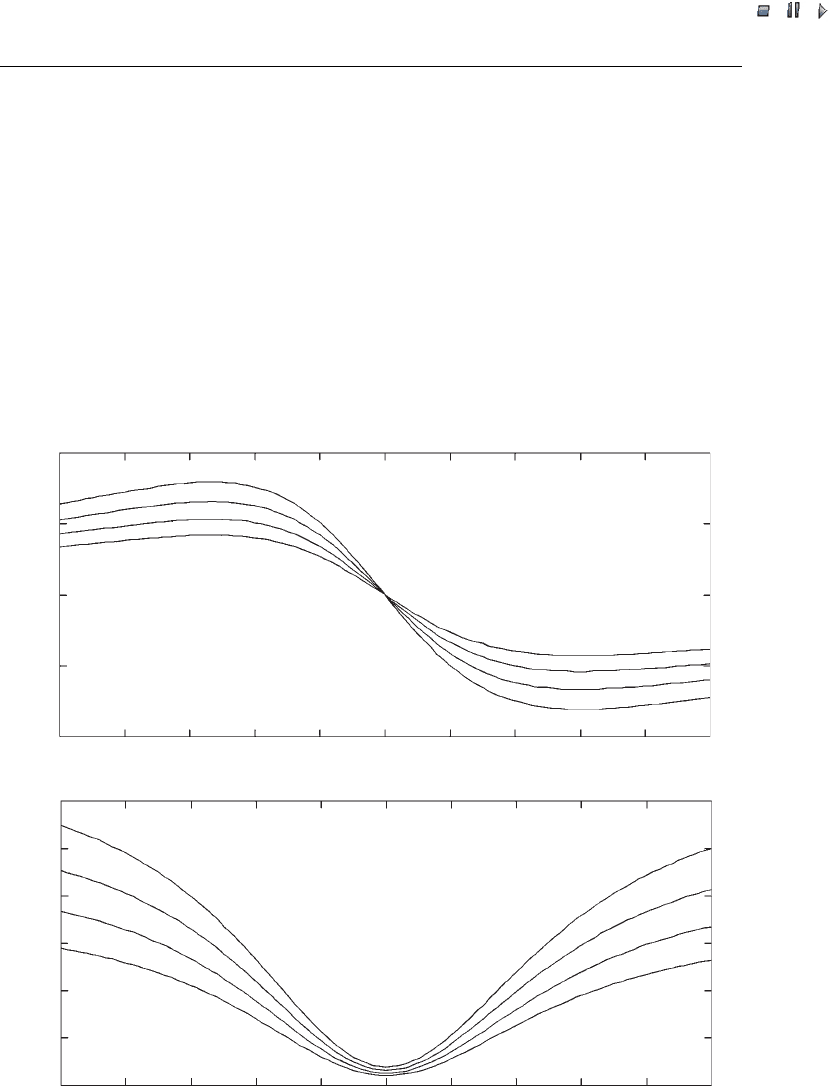
//INTEGRAS/KCG/P AGIN ATION/ WILEY /WPS /FINALS_1 4-12- 04/0470855088_ 20_CHA19 .3D – 422 – [411–432/22]
17.12.2004 10:55PM
reactive power are correlated and therefore node voltages can be controlled by changing
the reactive power generation or consumption of generators. An analysis of the voltage
control capabilities of the wind turbine types described in Section 19.3.1 has thus to show
to what extent they can vary their reactive power output. In the following, we will discuss
the voltage control capabilities of each of the wind turbine types described above.
Constant-speed wind turbines (Type A) have squirrel cage induction generators that
always consume reactive power. The amount of the reactive power consumption depends
on the terminal voltage, active power generation and rotor speed. Figure 19.3 illustrates
the relation between terminal voltage, rotor speed, active power generation and reactive
power consumption. This figure shows that a squirrel cage induction generator cannot be
used for voltage control, because it can only consume and not generate reactive power and
because the reactive power exchange with the grid cannot be controlled but is governed by
rotor speed, active power generation and terminal voltage.
–0.08–0.1 –0.06 –0.04 –0.02 0 0.02 0.04 0.06 0.08 0.10
–0.08 –0.06 –0.04 –0.02 0 0.02 0.04 0.06 0.08 0.10
0
2
4
6
5
4
3
2
1
0
–0.1
Active power generation (p.u.)
Reactive power consumption (p.u.)
Slip
Slip (p.u.)
U
t
= 1.1 p.u.
U
t
= 1.0 p.u.
U
t
= 0.9 p.u.
U
t
= 0.8 p.u.
U
t
= 1.1 p.u.
U
t
= 1.0 p.u.
U
t
= 0.9 p.u.
U
t
= 0.8 p.u.
–2
–4
(a)
(b)
Figure 19.3 Dependence of (a) active and (b) reactive power of a squirrel cage induction
generator on the rotor speed, with the terminal voltage, U
t
, as a parameter
422 Voltage Control

//INTEGRAS/KCG/P AGIN ATION/ WILEY /WPS /FINALS_1 4-12- 04/0470855088_ 20_CHA19 .3D – 423 – [411–432/22]
17.12.2004 10:55PM
The fact that a squirrel cage induction generato r consumes reactive power can be a
disadvantage, particularly in the case of large wind turbines or wind farms and/or weak
grids. In such cases, the reactive power consump tion may cause severe node voltage
drops. Therefore, the reactive power consumption of the generator is in most cases
compensated by capacitors, as depicted in Figure 19.2(a). In this way, the reactive power
exchange between the combination of the generator and the capacitors, on the one hand,
and the grid, on the other, can be reduced thus improving the power factor of the system
as a whole.
A conventional capacitor is an uncontrollable source of reactive power. By adding
compensating capacit ors, the impact of the wind turbine on the node voltages is
reduced. But this is only a qualitative improvement. The voltage control capab ilities
as such are not enhanced, because there is still a unique relation between rotor speed,
terminal voltage and active and reactive power generation. The voltage control capabil-
ities of a constant-speed wind turbine can be enhanced only with use of more advanced
solutions instead of conventional capacitors. Such advanced solutions include control-
lable sources of reactive power, such as switched capacitors or capacitor banks, a static
condensor (Statcon) or a static VAR compensator (SVC). An example of this is the use
of an American Superconductor D-VAR
TM
system in combination with a wind farm
with constant-speed wind turbi nes at Minot, ND.
(1)
The reactive power generation of a doubly fed induction generator (Type C wind
turbine) can be controlled by the rotor current, as will be discussed in more detail in
Chapter 25. In this case, there is no unique relation between reactive power and other
quantities, such as rotor speed and active power generation. Instead, at a particular
rotor speed and the corresponding active power generation a widely varying amount of
reactive power can be generated or consumed.
Figure 19.4 illustrates the operating range of a doubly fed induction generator at
nominal terminal voltage. It shows that the amount of reactive power is, to a certain
extent, affected by rotor speed and active power generation, as in the case of a squirrel
cage induction generator, even though it does not directly depend on these quantities.
The reason is that both generator torque and reactive power generat ion depend directly
on the current that the power electronic converter feeds into the rotor. The part of the
current that generates torque depends on the torque set point that the rotor speed
controller derives from the actual rotor speed. The current that is needed to generate
the desir ed torque determines, in turn, the converter capacity that is left to circulate
current to generate or consume reactive power.
In the case of a direct-drive variable-speed wind turbine (Type D), the reactive power
exchange with the grid is not determined by the properties of the generator but by the
characteristics of the grid side of the power electronic converter. The generator is fully
decoupled from the grid. Therefore, the reactive power exchange between the generator
itself and the generator side of the converter as well as between the grid side of the
converter and the grid are decoupled. This means that the power factor of the generator
and the power factor of the grid side of the converter can be controlled indep endently.
(1)
D-Var
TM
is a trademark of American Superconductor.
Wind Power in Power Systems 423
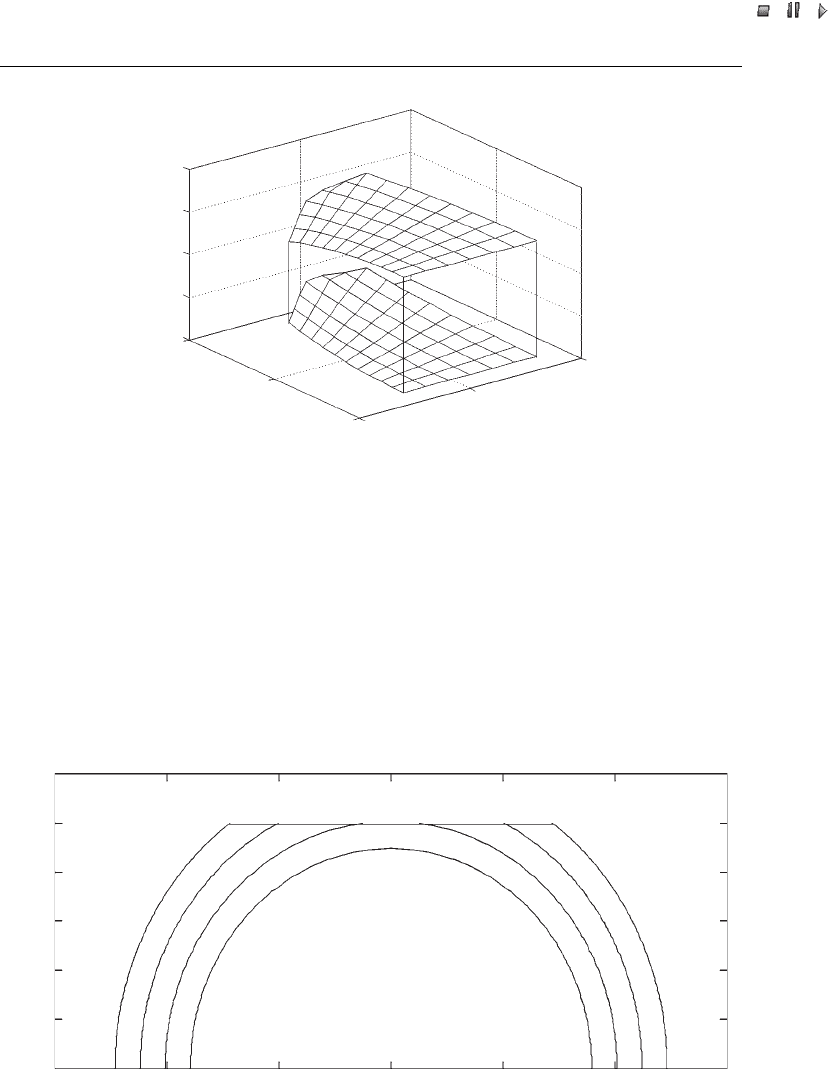
//INTEGRAS/KCG/P AGIN ATION/ WILEY /WPS /FINALS_1 4-12- 04/0470855088_ 20_CHA19 .3D – 424 – [411–432/22]
17.12.2004 10:55PM
Figure 19.5 shows the operating range of a variable-speed wind turbine with a direct-
drive synchronous generator, with the terminal voltage as a parameter. The rotor speed
is not taken into accou nt. As the generator and the grid are decoupled, the rotor speed
hardly affects the grid interaction. It is assumed that at nominal voltage and power the
wind turbine can operate with a power factor of between 0.9 leadi ng and 0.9 lagging.
Figure 19.5 illustrates that a variable-speed wind turbine with a direct-drive synchro-
nous generator allows control of react ive power or terminal voltage, because many
values of reactive power correspond to a single value of active power. It should be noted
Generator speed (p.u.)
Active power (p.u.)
1.5
1.0
1.0
0.5
0.5
0
2
1
0
–1
–2
Reactive power (p.u.)
Figure 19.4 Operating range of a doubly fed induction generator
Reactive power (p.u.)
–1.5 –1 –0.5 0 0.5 1.51
1.2
1
0.6
0.8
0.4
0.2
0
Active power (p.u.)
U
t
= 1.1 p.u.
U
t
= 1.0 p.u.
U
t
= 0.9 p.u.
U
t
= 0.8 p.u.
Figure 19.5 Operating range of a wind turbine with a direct-drive synchronous generator with
the terminal voltage, U
t
, as a parameter; the curves indicate the boundary of the operating range
with U
t
as a parameter
424 Voltage Control

//INTEGRAS/KCG/P AGIN ATION/ WILEY /WPS /FINALS_1 4-12- 04/0470855088_ 20_CHA19 .3D – 425 – [411–432/22]
17.12.2004 10:55PM
that in Figure 19.5 the curves indicate the boundary of the operating region, whereas in
Figure 19.3, they indicate a unique relationship.
19.3.3 Factors affecting voltage control
As discussed above, a wind turbine with voltage control capability can control node
voltages by changing the amount of reactive power that is generated or consumed. To
govern the control actions, the voltag e at a certain node is measur ed and fed into the
voltage controller. The controller determines the amount of reactive power to be
generated or consumed, according to the transfer function of the controller. It is easiest
to let the wind turbine control its own terminal voltage but sometimes the voltage at a
node somewhere else in the grid is controlled, although that node must be in the vicinity
of the turbine because of the local nature of the grid voltage. When the measured voltage
is too low, reactive power generation is increased; when it is too high, reactive power
generation is decreased.
The following factors influence the relation between the amount of reactive power
that is generated or consumed and the converter current that controls the reactive power
generation:
.
generator parameters (only in a wind turbine with a doubly fed induction generator);
.
the set point of the voltage controller;
.
values of the resistance, R, and the reactance, X, of the wind turbine grid connection;
.
the amount of active power flowing through the grid connection.
This chapter will look only at the influence of the last factor (i.e. the amount of active
power flowing through the grid connection). With respect to the other factors, the
following can be said:
.
Machine parameters are strongly related to machine size; therefore, all doubly fed
induction generat or based wind turbines of a given nominal power will have similar
generator parame ters. Therefore, generator parameters will hardly make a difference
in this context (Heier, 1998).
.
In practice, the set point of the terminal voltage will always be (nearly) equal to the
nominal value of the voltage. Therefore, the terminal voltage controller set point will
not play a major role.
.
For a more detailed discussion on the influence of the values of R and X of the grid
connection on the amount of reactive power that needs to be generated to keep the
voltage at the reference value, see Svensson (1996), among others.
19.4 Simulation Results
19.4.1 Test system
We use a simple arti ficial test system in order to quantitatively investigate the voltage
control capabilities of the various wind turbine concepts. The test system consists of a
wind turbine that is connected through an impedance to a strong grid, represented by an
Wind Power in Power Systems 425

//INTEGRAS/KCG/P AGIN ATION/ WILEY /WPS /FINALS_1 4-12- 04/0470855088_ 20_CHA19 .3D – 426 – [411–432/22]
17.12.2004 10:55PM
infinite bus. The nominal power of the wind turbine equals 2 MW, and its nominal
voltage is 700 V. The transformer is a three phase 700 V/10 kV transformer; the grid
voltage is 10 kV. The nominal frequency is 50 Hz. The resistance of the transformer and
the cable is 2:5 and their inductance is 16 mH, which corresponds to a reactance of
5j . Figure 19.6 shows the setup.
19.4.2 Steady-state analysis
First, the constant-speed wind turbine is analysed. For this type, voltage control is not
possible when a compensating capacitor of fixed size is used. There are studies of
systems with a reactive power source that can be controlled, such as capacitor banks
or FACTS (e.g. see Abdin and Xu, 2000). However, the product portfolios of major
wind turbine manufacturers show that this type of equipment is not part of standard
products. Further, when this kind of additional equipment is used it is still not the wind
turbine itself that controls the voltage but the extra device. As this chapter discusses the
voltage control capabilities of wind turbines, rather than dedicated voltage control
equipment, no further attention will be paid to such devices.
Chapter 25 includes the equations that can be used to calculate the amount of reactive
power consumed by a squirrel cage induction generator at a certain terminal voltage and
power output. The generator used here consumes 1.05 MVAR reactive power when
generating nominal active power at nominal terminal vo ltage. It is assumed that this
reactive power demand is fully compensated. To this end, a capacitor of approxim ately
6.8 mF has to be installed at each phase.
Figure 19.7 presents the results of the steady-state analysis of the constant -speed wind
turbine. The horizontal axis shows the active power generated by the wind turbine. The
vertical axis depicts the terminal voltage and the reactive power supplied to the grid. The
reactive power supplied to the grid equals the reactive power generated by the capacitor
minus the reactive power consumed by the squirrel cage inductio n generator.
Figure 19.7 shows that the reactive power decreases an d the terminal voltage increases
when active power generation increases. The decrease in reactive power generation can
be explained by the fact that when the active power generation increases, the reactive
power consumption of the squirrel cage induction generator increases as well. There-
fore, a minor part of the reactive power generated by the capacitor will be supplied to
the grid. The exact quantitative behaviour in a specific situation depends on the para-
meters of the generator and the grid connection (Svensson, 1996).
Strong
grid
Wind
turbine
U
t
P, Q
Z
I
= (2.5 + 5.0j) Ω
Figure 19.6 Test system for investigating the voltage control capabilities of wind turbine types.
Note: U
t
¼ terminal voltage; P ¼ active power; Q ¼ reactive power; Z
l
¼ line impedance;
j ¼
ffiffiffiffiffiffiffi
1
p
426 Voltage Control
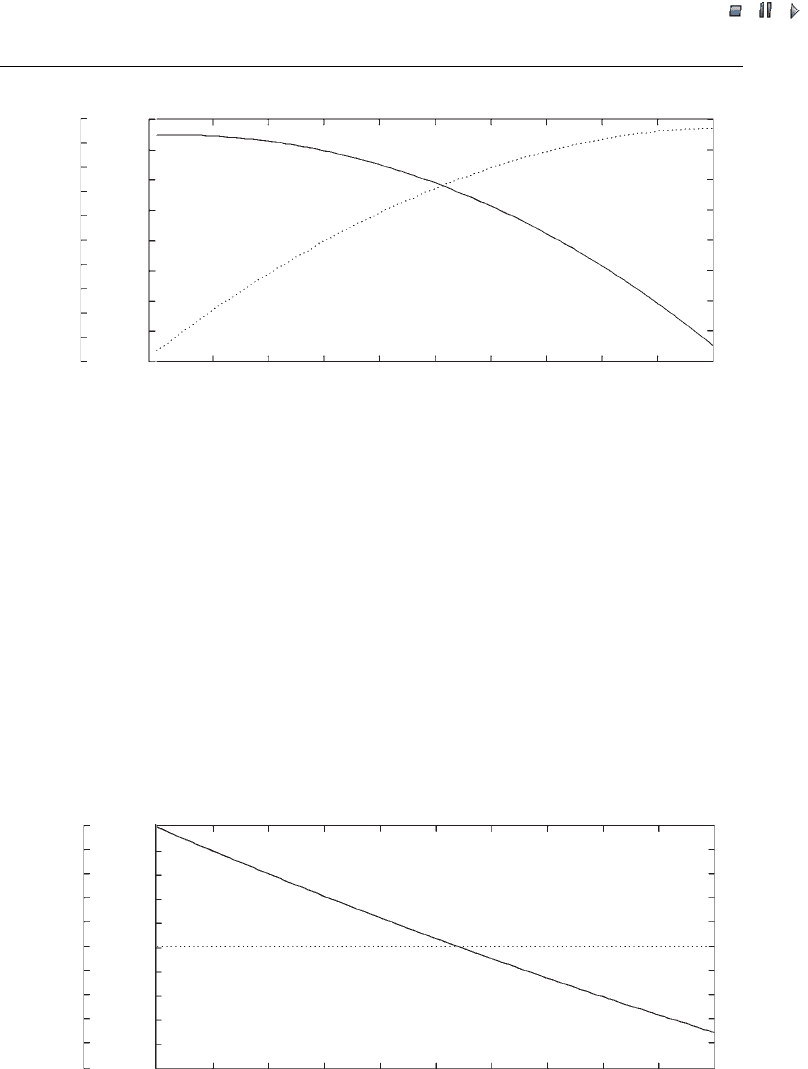
//INTEGRAS/KCG/P AGIN ATION/ WILEY /WPS /FINALS_1 4-12- 04/0470855088_ 20_CHA19 .3D – 427 – [411–432/22]
17.12.2004 10:55PM
Although the two variable-speed wind turbine types studied here have a different
generation system, they both allow full active and reactive power control, as described
above. In the steady-state analysis, only the terminal voltage and the exchange of active
and reactive power with the grid are studied. Therefore, it is unnecessary to analyse the
steady-state behaviour of the two varia ble-speed wind turbin e types separately.
Figure 19.8 shows the results of the steady-state analysis of variable-speed wind
turbines. In both cases, the wind turbine voltage controller control s the voltage at the
low-voltage (700 V) side of the transformer. The horizontal axis gives the active power
generated by the wind turbine. The vertical axis depicts the terminal voltage and the
generated reactive power. There is a marked difference between Figures 19.7 and 19.8.
In Figure 19.8 the terminal voltage varies; in Figure 19.8 it is constant.
Active power (MW)
734
732
730
728
726
724
722
720
718
716
714
Terminal voltage (V)
Reactive power (MVAR)
0.45
0.35
0.25
0.15
0.05
0.40
0.30
0.20
0.10
0 0.2 0.4 0.6 0.8 1 1.2 1.4 1.6 1.8 2
Figure 19.7 Results of the steady-state analysis of a constant-speed wind turbine using the test
system of Figure 19.6. Note: reactive power generated ¼ solid line; terminal voltage ¼ dotted line
Active power (MW)
Terminal voltage (V)
Reactive power (MVAR)
701.0
700.8
700.6
700.4
700.2
700.0
699.8
699.6
699.4
699.2
0
–1.0
–0.1
–0.2
–0.3
–0.4
–0.5
–0.6
–0.7
–0.8
–0.9
0.0 0.2 0.4 0.6 0.8 1.0 1.2 1.4 1.6 1.8 2.0
699.0
Figure 19.8 Results of the steady-state analysis of a variable-speed wind turbine with voltage
controller, using the test system of Figure 19.6. Note: reactive power generated ¼ solid line;
terminal voltage ¼ dotted line
Wind Power in Power Systems 427
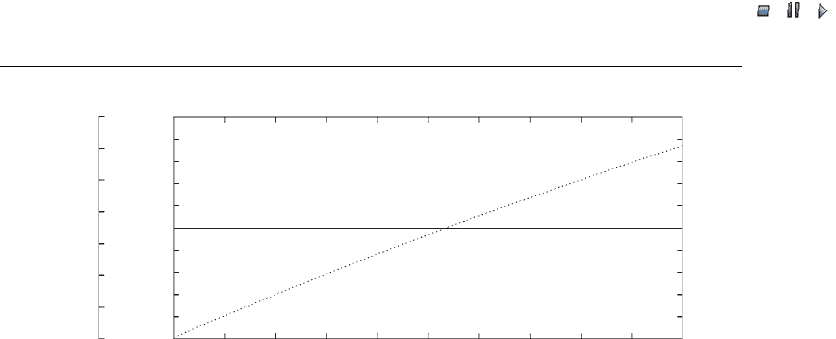
//INTEGRAS/KCG/P AGIN ATION/ WILEY /WPS /FINALS_1 4-12- 04/0470855088_ 20_CHA19 .3D – 428 – [411–432/22]
17.12.2004 10:55PM
Presently, converters in variable-speed wind turbines are often controlled in such a
way that no reactive power is exchanged with the grid. That means that a current with
the same phase angle as the grid voltage is injected, and the power factor, PF, equals 1
(see Section 19.2.2). This mode of operation will be further referred to as unity power
factor operation. Figure 19.9 presents the results of the steady-state analys is of this
operating mode. Owing to the relatively high impedance of the grid connection in the
test system, the variable-speed wind turbines did not perform very well at unity power
factor operation.
19.4.3 Dynamic analysis
This section analyses the dynamic behaviour of the three wind turbine concepts. We use
the same setup as for the steady-state analysis. When analysing the dynamic behaviour,
the two different variable-speed wind turbine types must be treated separately, because
they have different controllers for controlling the reactive power generation. In the wind
turbine with the doubly fed induction generator, reactive power is generated by con-
trolling the rotor current. In the wind turbine with a direct-drive synchronous generator,
reactive power is changed by controlling the grid side of the converter. Because the
transfer functions are different, the performance of the control systems may also differ
and the two types of variable-speed wind turbines are therefore simulated separately. To
illustrate the difference between wind turbines with and without a voltage controller, the
grid voltage will be dropped after 30 seconds from 10 kV to 9.75 kV. In reality, this can
happen when a large load is switched on or when a nearby synchronous generator trips.
Figure 19.10 shows the results of the simulation for a measured wind speed sequence.
Figure 19.10(a) depicts the wind speed sequence. Then, for each of the wind turbi ne
types, the generated active and reactive power and the terminal voltage are shown. For
the variable speed turbines, both voltage control operating mode and unity power factor
operating mode are studied. In the figure, the individual curves are labelled with the
wind turbine type to which they refer.
Active power (MW)
Terminal voltage (V)
Reactive power (MVAR)
735
730
725
720
715
710
705
700
0.0 0.2 0.4
0.6
0.8 1.0 1.2 1.4 1.6 1.8 2.0
0.10
0.08
0.06
0.04
0.02
–0.02
–0.04
–0.06
–0.08
–0.10
0.00
Figure 19.9 Results of the steady-state analysis of a variable-speed wind turbine with unity
power factor using the test system of Figure 19.6. Note: reactive power generated ¼ solid line;
terminal voltage ¼ dotted line
428 Voltage Control

//INTEGRAS/KCG/P AGIN ATION/ WILEY /WPS /FINALS_1 4-12- 04/0470855088_ 20_CHA19 .3D – 429 – [411–432/22]
17.12.2004 10:55PM
Time (s)
010
20
30
40
50
60
Constant speed
Doubly fed
Direct drive
2.0
1.8
1.6
1.4
1.2
1
0.8
Active power (MVV)
Time (s)
010
20
30
40
50
60
Constant speed
Variable speed at unity power factor
Direct drive with voltage controller
Doubly fed with voltage controller
1.0
0.8
0.6
0.4
0.2
0
–0.2
–0.4
–0.6
–0.8
–1.0
Reactive power (MVAR)
Time (s)
010
20
30
40
50
60
Constant speed
Variable speed with voltage controller
Direct drive at unity power factor
Doubly fed at unity power factor
740
730
720
710
700
690
680
Terminal voltage (V)
Time (s)
60
010
20
30
40
50
15
14
13
12
11
10
9
8
Wind speed (m/s)
(a)
(b)
(c)
(d)
Figure 19.10 Results of dynamic simulation of a constant-speed wind turbine and a variable-
speed wind turbine in either voltage control operating mode or unity power factor operating
mode: (a) wind speed, (b) active power, (c) reactive power and (d) terminal voltage. The individual
curves are labelled with the wind turbine type to which they refer
Wind Power in Power Systems 429

//INTEGRAS/KCG/P AGIN ATION/ WILEY /WPS /FINALS_1 4-12- 04/0470855088_ 20_CHA19 .3D – 430 – [411–432/22]
17.12.2004 10:55PM
The following conclusions can be drawn from Figure 19.10:
.
The voltage fluctuates most rapidly in the case of constant-speed wind turbines. The
reason is that the rotor has a constant rotational speed, because the generator is directly
coupled to the grid. Therefore, the rotating mass cannot be used as an energy buffer, as
is the case in variable-speed wind turbines. Changes in wind speed, as well as the effect
of the tower shadow, are directly reflected in changes in active power. The reactive
power consumed by the generator depends on the active power, which in turn influences
both the reactive power generated and the terminal voltage. This effect would be even
more pronounced if the tower shadow effect were included in the models.
.
The amplitude of the terminal voltage variations is high in the case of constant-speed
wind turbines and variable-speed wind turbines in unity power factor mode. This is
caused by the high impedance of the grid connection.
.
The terminal voltage variation is smoothest in the case of variable-speed wind
turbines with a vo ltage controller. As expected, a wind turbine with a terminal voltage
controller performs better than one without a terminal voltage controller.
.
Although the voltage controller works in a different way, the performance of both
variable-speed wind turbines is similar. If the controllers are well designed, both
variable speed-wind turbines perform equally well with respect to terminal voltage
control.
.
Finally, it is clear that wind turbines equipped with a voltage controller compensate
the grid voltage drop and keep the voltage at its reference value. Only variable-speed
wind turbine s with a voltage controller are capable of controlling terminal voltage
independently of the grid voltage, unless their operating limits are exceeded.
19.5 Voltage Control Capability and Converter Rating
The conclusion is that a variable-speed wind turbine with a voltage controller performs
best with respect to voltage control. Unfortunately, this does not come for free. For
both variable-speed wind turbines, voltage control requires power electronic converters
with a rating that is higher than the rating for operation at unity power factor.
In order to illustrate this, the converter current was calculated when the wind turbines
studied above generated nominal real power and:
.
did not generate reactive power;
.
generated nominal reactive power ;
.
consumed nominal reactive power.
We assumed that grid voltage and frequency equal their nominal values. The nominal
reactive power exchange with the grid was assumed to equal 1 MVAR. This c orresponds
to a power factor of approximately 0.9. For reactive power consumption and genera-
tion, we also calculated the relative change in converter current when compared with the
converter current in the unity power factor ope ration mode. The results are given in
Table 19.1. Even though the quantitative values are specific to the wind turbines studied
here, the qualitative conclusions can be applied more generally.
430 Voltage Control
